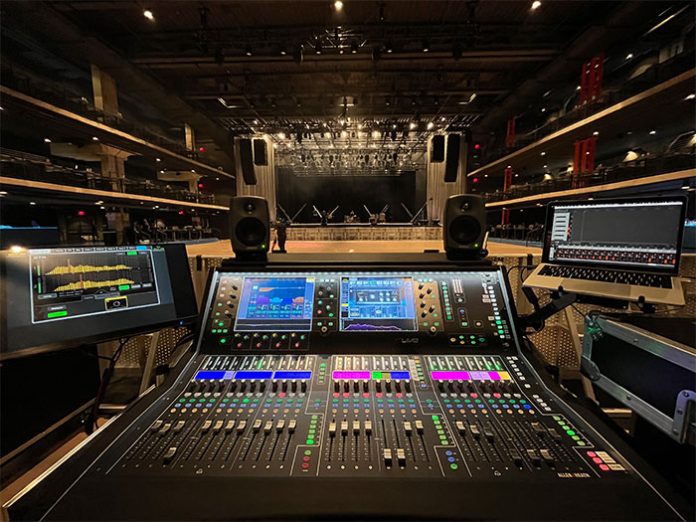Handling mixing duties for the tour are Daniel Good and Nahuel Gutierrez, who started working with Yeah Yeah Yeahs’ Karen O following her Danger Mouse collaboration Lux Prima in 2019.
“We did two shows at the Ace Hotel in Los Angeles and the band performed one more show in New York,” explained Good. “At that point we weren’t sure if Yeah Yeah Yeahs would ever be performing again, so it was cool to get contacted again after their album came out.”
Good and Gutierrez are each mixing on Allen & Heath dLive S5000 surfaces, along with DM0 MixRacks handling 128 channels of 96kHz input processing. For I/O, various DX168 expanders are distributed on the stage. A SuperMADI card was also included, which allows for a multichannel broadcast feed when needed, as well as a 128-channel Waves card for multitrack recording and playback.
The tour package was provided by Worley Sound: “We specialize in custom control packages for our clients,” explained founder Tom Worley. “I think the Allen & Heath price point really speaks to a lot of mid-sized tours that want a compact footprint, and flexibility of I/O expansion through cards and stageboxes.”
Good had limited experience on Allen & Heath’s dLive platform prior to this tour, but the console had left a good impression on him. “I just remembered that it sounded great, and five or six years later it kicked into my mind again. The way you can lay out Allen & Heath consoles and configure the hardware any way you want – we knew that it could accomplish what we needed quickly and easily.”
“I liked that the console was really easy to understand,” noted Gutierrez, who handled Yeah Yeah Yeahs’ monitor mixing. “It fit the budget, and it was great to have the shared stageboxes for Good and myself. It saved us a lot of space and weight in the touring package. The more we used the consoles, the more we liked them.”
Gutierrez noted: “We basically mix everything in the box, the DYN8 dynamic EQ is fantastic, as well as all the onboard FX and parallel compression options.Good has also been getting amazing reviews because the shows have been sounding fantastic.”
Gutierrez commneted on the Source Expander plugin “That’s becoming a really good tool to clean mixes, I have it inserted on cymbals, vocals, and a couple of the open mics that are not used frequently to eliminate background noise.”
Gutierrez employed the Dual Stage Valve preamp emulation. “It’s probably one of the best vocal distortions I’ve heard,” he continued. “We’ve tried pedals and a few other solutions, but nothing sounded right until we found this emulation.” Good also uses the various preamp models at front of house to add more colour to his mix. “I was blown away when I first discovered those,” he recalled. “They’re so versatile, you can pretty much get anything you want out of a channel.”
Both engineers rely on dLive’s Scenes feature to recall preset mixes for each song in the band’s set. “As the tour progressed, I picked up on little things I wanted to tweak – adding in EQ changes, fader movements, and panning. It’s pretty awesome that dLive allows you to scope the dynamic EQ separately from the rest of the channel processing, that’s something I’ve always wanted to do,” explained Good.
For on-stage monitoring, Yeah Yeah Yeahs rely almost entirely on IEMs for their current tour. “Everyone uses in-ears except for the drummer, who receives stems into a small mixer and does his own headphone mix,” explained Gutierrez. “It’s the first full tour for the band on in-ears – but once they got used to them, they were really happy with it.”
At FOH, Good uses dLive’s display output to set up a live RTA on an external monitor. “It’s cool to have that without having SMAART, to see how things are translating. Karen will jump mics sometimes – I need to be ready to swap from wired mics to wireless instantly and in pitch black, so I can do that now with a single button push.”
“The engineers seem to really be enjoying the consoles and having great results,” said Tom Worley. “Even the band was telling me how the sound is improved and how happy they are.”






